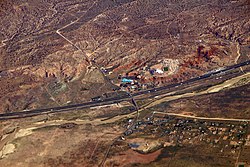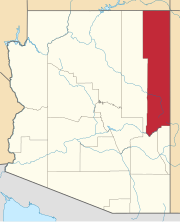Sanders, Arizona: Difference between revisions
Navajoindian (talk | contribs) No edit summary Tag: Mobile edit |
|||
| Line 79: | Line 79: | ||
==Navajo Culture== |
==Navajo Culture== |
||
The Navajo People have a big presence in the area making it |
The Navajo People have a big presence in the area making it made |
||
up of mainly Navajo's with some still living in traditional Hogans and herding sheep along with some practicing sacred dances such as The Yeii Bii Cheii dance (a winter ceremony of the Navajo's) which are sometimes held near the area in the winter. |
|||
==Demographics== |
==Demographics== |
||
Revision as of 21:00, 27 March 2014
Sanders, Arizona | |
|---|---|
 Sanders and I-40 from the air | |
| Country | United States |
| State | Arizona |
| County | Apache |
| Area | |
• Total | 2.4 sq mi (6.2 km2) |
| • Land | 2.4 sq mi (6.2 km2) |
| • Water | 0.0 sq mi (0.0 km2) |
| Elevation | 5,865 ft (1,788 m) |
| Population (2010) | |
• Total | 630 |
| • Density | 263/sq mi (101.6/km2) |
| Time zone | UTC-7 (MST) |
| • Summer (DST) | UTC-6 (MDT) |
| ZIP code | 86512 |
| FIPS code | 04-63050 |
| GNIS feature ID | 0010911 |
Sanders (Template:Lang-nv) is an unincorporated community and census-designated place (CDP) in Apache County, Arizona, United States. Sanders is located at the junction of U.S. Route 191 and Interstate 40, within the Navajo Nation and Nahata Dziil ( New Lands) Navajo Chapter . As of the 2010 census, it had a population of 630, the nearest towns near Sanders are all evenly distributed as either 40 to 60 miles both ways. Sanders is protected by The Apache County Sheriff Dept, AZ state police and also The Navajo Nation Police all which cover the Sanders area..[1]
Sanders has the ZIP code 86512.
Geography
Sanders is located at 35°12′59″N 109°20′01″W / 35.21639°N 109.33361°W (35.21649, -109.33366), at Exit 339 on Interstate 40. By I-40 it is 6 miles (10 km) west to Chambers, 53 miles (85 km) west to Holbrook, and 44 miles (71 km) east to Gallup, New Mexico. U.S. Route 191 leads south 54 miles (87 km) to St. Johns.
According to the United States Census Bureau, the Sanders CDP has a total area of 2.4 square miles (6.2 km2), all of it land.[1]
Sanders is located on the edge of The Defiance Plateau (North), Puerco Valley and also The Puerco Ridge (South). The main vegetation that makes up the area is Cedar and Pinón also with a variety of native plants such as prickly pear cactus,sage, etc....
Wildlife is abundant here which includes Pronghorn, Deer, Cougars, Coyotes, and Elk in the winter time along with Turkeys and Quail.
History
Sanders is named either after C. W. Sanders, a railroad office engineer; or Art Saunders, who had a trading post nearby. The railroad station was named Cheto to avoid a pre-existing station named Sanders already on the line. sanders is located near Interstate 40 and The BNSF Railway, Sanders is surrounded by the Navajo Nation and Nahata Dziil Navajo Chapter which is made mostly of Relocated Navajo's from the Navajo Hopi Land Dispute which ultimitly led to thousands of Navajo's being relocated to the area of Sanders AZ which was then mostly ranch lands, till the US government bought and added to the Navajo Nation in 1981. [2]
Notable Navajo's
Calvin Henderson Murphy(1921-2002) Calvin H. Murphy was a Navajo Code Talker under the Fith Marines Division, he served in WW2 in the South Pacific as a code talker for the US, he was one of 400 Navajo's to serve as a Navajo Code Talker during the conflict in the pacific against the Japanese Empire, he was born in 1921 to Pat Murphy ( Navajo) and Edith Murphy ( German Navajo)
Pat Murphy (Jaa'tł'óół Ninéézii) 1870-? Retired Navajo Santa Fe worker from Querino Canyon AZ who was the first Navajo to receive benefits (retirement,railroad benefits) from both the US government and Santa Fe Railroad during the early 1920's and 30's, as a Native American Worker which back then was hard to get for an Navajo Indian worker to both retire and receive benefits which then led to retirement from more Navajo's "first for the Navajo's"
Navajo Culture
The Navajo People have a big presence in the area making it made
up of mainly Navajo's with some still living in traditional Hogans and herding sheep along with some practicing sacred dances such as The Yeii Bii Cheii dance (a winter ceremony of the Navajo's) which are sometimes held near the area in the winter.
Demographics
As of the census of 2010, there were 630 people, 200 households, and 151 families residing in the CDP. The population density was 262.5 people per square mile (101.6/km²). There were 242 housing units at an average density of 100.8/sq mi (39.0/km²). The racial makeup of the CDP was 71.4% Native American, 22.7% White, 0.2% Black or African American, 0.5% Asian, 0.2% Native Hawaiian or other Pacific Islander, 0.8% some other race, and 4.3% from two or more races. 3.8% of the population were Hispanic or Latino of any race.[3]
There were 200 households out of which 48.5% had children under the age of 18 living with them, 44.5% were headed by married couples living together, 25.0% had a female householder with no husband present, and 24.5% were non-families. 21.0% of all households were made up of individuals, and 4.5% were someone living alone who was 65 years of age or older. The average household size was 3.15, and the average family size was 3.71.[3]
In the CDP the age distribution of the population was 37.1% under the age of 18, 9.7% from 18 to 24, 24.0% from 25 to 44, 21.3 from 45 to 64, and 7.8% who were 65 years of age or older. The median age was 26.8 years. For every 100 females there were 84.8 males. For every 100 females age 18 and over, there were 80.0 males.[3]
For the period 2007-11, the estimated median annual income for a household in the CDP was $23,816, and the median income for a family was $24,375. The per capita income for the CDP was $6,741. About 36.6% of families and 33.1% of the population were below the poverty line.[4]
Education
Education in the community is organised by Sanders Unified School District. Sanders Elementary School provides for education from kindergarten to grade 5 with Sanders Middle School operating from grades 6 to 8. Valley High School provides high school education.
References
- ^ a b "Geographic Identifiers: 2010 Demographic Profile Data (G001): Sanders CDP, Arizona". U.S. Census Bureau, American Factfinder. Retrieved April 30, 2013.
- ^ Byrd H. Granger (1960). Arizona Place Names. University of Arizona Press. p. 22. Retrieved 9 December 2011.
- ^ a b c "Profile of General Population and Housing Characteristics: 2010 Demographic Profile Data (DP-1): Sanders CDP, Arizona". U.S. Census Bureau, American Factfinder. Retrieved April 30, 2013.
- ^ "Selected Economic Characteristics: 22007-2011 American Community Survey 5-Year Estimates (DP03): Sanders CDP, Arizona". U.S. Census Bureau, American Factfinder. Retrieved April 30, 2013.

